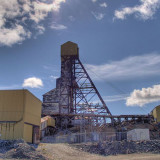
By Bob Weber, The Canadian Press
YELLOWKNIFE – Plans to clean up what may be Canada’s worst toxic site are moving ahead with changes suggested by those who live beside Yellowknife’s Giant Mine.
Last summer, a northern environmental regulator told the federal cabinet that it wasn’t entirely happy with Ottawa’s plans for the mine, which holds millions of tonnes of arsenic-contaminated waste on the shores of Great Slave Lake.
The Mackenzie Valley Review Board agreed freezing the underground arsenic in place is probably the best solution.
But it sided with aboriginal groups, territorial politicians and the City of Yellowknife, who have strong reservations with the federal plan.
The board eventually recommended an independent watchdog be created to supervise the dangerous cleanup. And it wanted ongoing research funded to find a permanent way to deal with the former gold mine’s deadly legacy, as well as the health and environmental effects of the cleanup.
It also disagreed with federal plans to maintain the frozen arsenic in perpetuity, pointing out forever is a long time. said the board’s report last June:
[quote]The public (does) not have any confidence the (government) can be trusted to fund and actively manage the site forever as proposed.[/quote]
The board recommended a 100-year limit on the time the arsenic can be kept frozen underground. It also said the plan must be reviewed every 20 years.
All those suggestions have survived a consultation process with federal bureaucrats, and have made it into the final draft of the board’s recommendations, submitted this week.
“The board carefully weighed what it got from those parties,” said board manager Alan Ehrlich. “We believe that their underlying interests remain in the recommended measures.”
The recommendations now go before Northern Development Minister Bernard Valcourt.
That document is the result of consultations that began in 2008. It proposes the freezing of 237,000 tonnes of highly toxic and soluble arsenic underground, with 65 kilometres of refrigerating pipes running through cavernous subterranean storage chambers.
There are also 13.5 million tonnes of arsenic-contaminated tailings on the land above. The 95-hectare site contains many structures that are further contaminated with arsenic and other poisons, from asbestos to dioxins.
Some of the structures are in such bad shape the government was forced to apply for emergency permits to take them down last summer before toxins were released.
The latest cost estimate for the entire project is $903 million — all which will be paid by taxpayers.


This whole outrageously costly mess at the Giant Mine is a cautionary tale regarding mines and mining executives.
Peggy Witte and investors were the owners of this mine. I remember her for her extreme antagonism to taxation, and her yet even more extreme antagonism toward the NDP government of B.C. in the nineties. This animosity was, certainly to an extent, shared by her collegues and was likely in some part due to the fact that the public were starting to cotton on to the environmental damage that was resulting from some of these operations, and the distinct likelyhood that an NDP government was much more likely to represent the public interest. A prime example is the tailings ponds that for decades previous, had been legislated to be built to contain the toxic materials in perpetuity at mine sites. However, about this time it became public knowledge that these were little more than pits lined with plastic sheeting.
Anyway, Peggy organized a grand P.R. exercise that was the faux movement of the mining industry to Chile, provoked, she claimed, by the two issues of taxation and of the NDP government.The mining convention in 1993 or 1994 held in Vancouver had it’s total focus on this supposed movement, with the exception of one invited speaker, the provincial NDP Minister for mines. (Now that’s a prime example of a political set-up!!).
Subsequent to walking away from the Giant Mine mess and leaving the public holding the bag, she bought a defunct company that had staked a rich deposit in what became the Spatsizi Wilderness Park. She then sued the public for damages for preventing the development of this claim. She also had bought another company having rich mineral claims in a remote, inaccessible area. She settled with the government for road access and a 375 km high voltage hydro line into the site, allowing development of the Kemess mine. Further, she had the temerity to sue the government again for the timber that was either on the line right of way or on the access road, or perhaps both. I can’t remember the outcome of this.
We and our elected representatives need to be very wary of these mining executives. Money drives their every move. Peggy and the Giant Mine are a textbook example.
I worked there in the mid ’70’s. The place is cavernous all right.
With all that winter cold, one would wonder if they could use a Giant – excuse the pun – radiator to transfer the heat out from underground passively once they have managed to get the ground frozen during the first 20 yr period of active heat pumping? That would be a good thing because you sure can’t depend on the government to do anything year to year, let alone ‘for ever’.